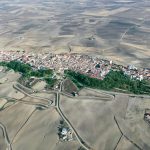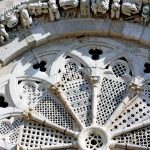Troia
We continue the itinerary approaching the Tavoliere plain where, on a cliff just over 400 meters high, rises the wonderful city of Troia. It is among the newly established centers built by the catapano Bojannes along the border line with the Longobard Duchy of Benevento and, together with nearby Lucera, it became the central hub of the Byzantine defensive system of the Capitanata.
The Bojannes’ choice of the site responded to strategic reasons: the city, in fact, arose in 1019 on the site of the destroyed Aecae, a settlement active since pre-Roman times, which later became an important municipium thanks to the transit of the Traiana-Irpinia road. Thanks to the spiritual heritage of the ancient center, already a vital bishop’s seat, and to the hinge position for the direct traffic on one side to Bari and Brindisi, on the other to the Gargano, it became an important stop on the pilgrimage routes. Here, for example, there was the hospital of Saint Mark and, in the citations of the time, the Traiana road is expressly mentioned with the name of “Via Francigena” (Francigena road), the itinerary of faith that connected Central Europe with the Holy Land.
With the arrival of the Normans, the city became an important and privileged center, so much so that Robert the Guiscard made it his favorite residence granting numerous privileges. As a center of spiritual irradiation, the magnificent Cathedral dedicated to the Assumption was erected, one of the most noteworthy episodes of Romanesque art in Puglia. The construction is documented as early as 1083, but the architectural history of the current building began in 1093 to end in the Federician season. The sculptural cycle that reproduces a lively repertoire of medieval iconography is very rich. Apart from the famous rose window, a special mention deserves the two bronze doors, a masterpiece created between 1120 and 1130 by the founder Oderisio of Benevento.
Also of great architectural value is the medieval church of St. Basil Magnus, with elements of reuse of the Roman era. In addition to the rich architectural heritage, the city preserves other precious evidence of history and art at the Civic Museum and the Cathedral Treasure, where, among other things, the rare Exultet rolls are kept , miniated parchment codices of XI- Twelfth century of exceptional documental value.
PLACES TO GOIn town
The Cathedral of the Assumption. The church of St. Basil Magnus. The Diocesan Museum with the rich treasure of the Cathedral. The Bishop. The church of St. Vincent the Martyr and Levite. The baroque church of Saint Francis, with valuable paintings and sacred furnishings. The church of Saint John at Market with paintings by Luca Giordano. Some splendid 16th century buildings like D’Avalos palace. The complexes of Saint Dominic and St Benedict.Nearby
Archaeological site of Vaccarizza. The Celone river.Roberta De IulioEVENTS CALENDAR
- On March 8th, the procession of Saint John of God.
- Fires of St. Joseph on March 19th.
- Rites of Holy Easter with the Procession of the Chains on Friday morning, Procession of the Mysteries on Friday evening and the Kiss on Easter Sunday.
- Procession of the Crowned Madonna on the last Sunday of April.
- Procession of Madonna of Intercession on the last Sunday of May.
- Saints day festival from 17 to 20 July.
- Saint Lawrence’s country festival on August 10th.
- Second Sunday of September, feastival of Our Lady of Hope.


